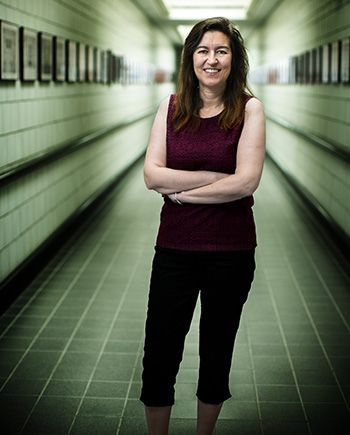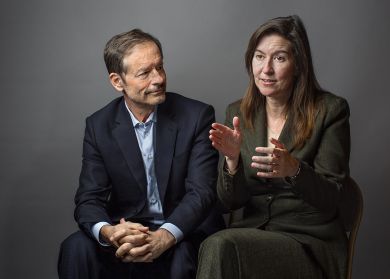Immunotherapy, Improving the Odds
This feature first appeared on the Cornell Research site. Read the original here.
In August 2015, former President Jimmy Carter announced that he had cancer that had spread to his brain. By December of that year—after a combination of radiation, surgery, and a new immunotherapy—doctors found no traces of the disease, and Carter was deemed cancer-free. The immunotherapy doctors gave him triggered his own immune system to fight against the cancer, a fight he seems to be winning.
For select patients, immunotherapies have shown dramatic results such as this, but many others don’t respond. Kristy L. Richards, Biomedical Sciences, wants to make immunotherapies work for more patients. With a joint appointment in Hematology and Medical Oncology at Weill Cornell Medicine, she studies lymphoma, why some patients with the cancer respond to immunotherapies and others don’t, as well as which combination of treatments could improve survival.
One research challenge Richards and other immuno-oncologists face is that the human immune system is impossible to replicate in a dish. Richards’ answer has been to develop clinical trials in dogs—pet dogs already diagnosed with lymphoma. Not only do the dogs stand to benefit but also the pace and efficacy of drug development. Richards says that with a $2.6 billion price tag and as much as a 20-year timeline to develop a new drug, accelerating the process and lowering costs is imperative for patients and society.
Exceptionally Challenged Immune Systems
“Dogs eat dirt. They lick the floor. Their immune systems are really challenged,” Richards says. “They live in our environment and are challenged by the same things as us, in general.”
Mouse models, on the other hand, are kept in a sterile environment, where their immune systems remain underdeveloped. Dogs are also more genetically similar to humans, and the way tumors arise in pet dogs more closely resembles human tumors’ spontaneous growth.
For sick dogs and their owners, the clinical trials have many benefits. The dogs get treated with more attention, and owners have a treatment option if they couldn’t otherwise afford one. Dogs also can’t tolerate high doses of chemotherapy, and the low doses they can handle almost never cure them. Having a nontoxic option provides another avenue for prolonged life.
“I love that dogs benefit,” Richards says. “And once we show that a chemo-free regimen works in dogs, then we can make a better guess about how it’ll work in humans.”
Monoclonal Antibody Therapies
One of the immunotherapies that Richards plans to test in dogs involves monoclonal antibodies. These are proteins that can recognize cancerous cells and flag them for the immune system to attack. Richards is currently experimenting with various antibodies to see which will work best for lymphoma and why.
A longstanding effort in Richards’ lab has been to understand and improve a popular monoclonal antibody prescribed for human patients with lymphoma, called rituximab.
Rituximab has increased survival rates in the most common lymphoma subtype by 15 percent, from 50 percent survival before rituximab to 65 percent after. “It was really a blockbuster drug,” Richards says. But because it quickly became so widely used, given in combination with every chemotherapy regimen, little is known about why certain people respond and others don’t.
Richards is studying a polymorphism that may provide one piece of the puzzle. Eventually, she would like to identify and develop a biomarker and assay that could be used to predict a patient’s response to rituximab. At around $20,000 for a course of the drug, this test could save patients and taxpayers money, while also shedding light on the 35 percent of patients with resistance.
Some of the other immunotherapies Richards works on could be straight out of science fiction. One is based on immune checkpoint inhibitors, the type Carter received, which take the brakes off of the immune system. This makes the immune system more sensitive and therefore more aggressive.
Another therapy involves the making of CAR (Chimeric Antigen Receptor) T cells, where a monoclonal antibody is inserted into a T cell, one of the body’s immune cells. The antibody is expressed on the surface of the T cell, where it can find and bind to cancer cells, bringing the T cell with it. “This takes the immune system to the cancer cell and activates the T cell, so it’s basically like a guided missile,” Richards says. “Some people have responded dramatically to this type of therapy.”
For the many who don’t respond, Richards is wondering whether combining the immune checkpoint inhibitors with CAR T-cell therapy might work. In collaboration with Richard Koya and other researchers at Roswell Park Cancer Institute and Cornell, she’s developing a CAR T cell to test with dogs.
PATh, Leveraging Collaborative Expertise
The canine clinical trial program is part of a large collaborative effort, coordinated by Richards, to accelerate the development of therapeutics. Called PATh (Progressive Assessment of Therapeutics), the aim is to leverage the expertise of more than 50 researchers in Ithaca and at Weill Cornell Medicine to solve a big problem in drug development.
“Only seven percent of oncology therapies that go into human clinical trials make it out the other side, and it’s hugely expensive and time-consuming,” Richards says. “We’re trying to improve all levels of preclinical testing, with the idea of making it more efficient—costing less and happening faster. As a society, we can’t sustain the current drug development pipeline.”
Essential to improving the forecasts for drugs in human trials is better preclinical models—dogs being one. PATh also encompasses improved mouse models from John Schimenti and Robert Weiss, Biomedical Sciences, and collaborators at Weill Cornell Medicine. This includes PDX mouse models, on which the cells of a human tumor can be transplanted, grown, and treated. Ankur Singh, Sibley School of Mechanical and Aerospace Engineering, and others from the College of Engineering, are building organoids, improved in vitro models of cancer cells’ natural environment.
Richards hopes the PATh program will fill the gap between the high-yield, compound-producing pharmaceutical companies and the highly-regulated human clinical trials, where each drug in a treatment regimen has to be tested separately over the course of years. “A pie in the sky idea is that eventually pharmaceutical companies could come to us. We could run their top compounds through all these models—in vitro with organoids, in vivo with the mouse models, and the super in vivo with dogs—and rapidly, in a year, be able to tell them which ones have the best chance of success. It would tilt the odds in our favor in the human clinical trials and make a 20-year drug development process into, maybe, a five-year one.”
An alumna of Cornell, Richards said after graduating that she never wanted to come back to Ithaca because of the weather. “Then we were deciding where my lab should be, and I knew we needed somebody with feet on the ground in both places. As an MD, I need to be sitting with the DVMs. Otherwise, there’s no bridging. So Ithaca it was. And actually I spoke too soon. I love it here.”Not only does the PATh program aim to bridge this gap in the drug pipeline, it also aims to bridge the Ithaca campus with Weill Cornell Medicine in New York City. As an MD, Richards is a part of that bridge.
Richards cites the many disciplines coming together in the PATh program as well as the tremendous resource of the College of Veterinary Medicine at large. She works with people such as Adam Boyko, Biomedical Sciences, who is compiling a database of the genomes of thousands of dogs. Having this kind of genetic information, in combination with known disease susceptibilities of certain breeds, will allow Richards and others to practice precision medicine in dogs. Richards says that the research possibilities abound, as well as the potential impact on human health.
“Cornell is just perfect for the kind of work I’m doing,” she adds.
Since her PhD work in Genetics at Stanford University, Richards has always been fascinated by the commonalities between organisms, how so many genes are conserved. Looking at disease in dogs to understand disease in humans came naturally to her, she says. “I’ve always had this comparative philosophy, and the multidisciplinary effort at Cornell is another way of pursuing the comparative approach. What happens when engineers, biologists, pathologists each look at the same issue? By comparing different viewpoints, you learn a lot,” she explains. “Comparative oncology is a natural fit with the radical collaboration concept—that’s why it all works.”




